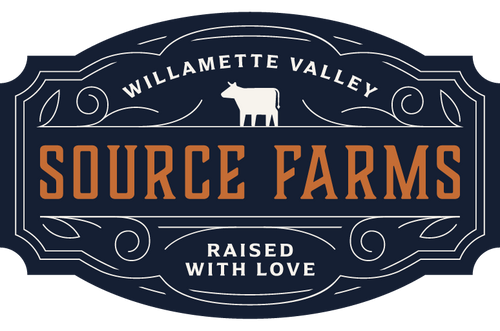We pride ourselves on raising pasture-raised proteins – our pork being no exception. Our hogs spend warmer days roaming through lush pastures and forests in Carlton, enjoying their time foraging or munching on veggie scraps from our garden and a locally made, non-GMO feed mix. In the winter, they are cozy in their Korean Natural Style Piggery and are on pasture during the dry weeks. Korean Natural Farming mimics the forest floor – it is a microbially-inoculated deep litter system that utilizes layers of biochar, logs, wood chips, and sawdust. Plus, the heat from the natural composting keeps them nice and warm.
Our founding farm, Tabula Rasa Farms, raises a few breeds of hogs that are well suited for life in the Pacific Northwest due to their love of foraging and hardiness for the weather we have. You’ll find Heritage-Cross, Red Wattle, and American Guinea Hogs on the farm. Originally from England, our Berkshire Heritage-Cross pigs have a beautiful red-pink color and tender and juicy meat. Our Red Wattle pigs are a distinctly American breed of pig known for their red meat and their unique earthy and robust flavor. Finally, we occasionally raise American Guinea Hogs (AGH). A specialty breed of pork, AGH has a generous amount of fat on each cut making their meat sweet and buttery.

Pasture-raised pork is more nutrient-dense than store-bought pork. They contain higher levels of healthy Omega-3 fats, protein and Vitamin D and E. Because of their foraging diets, our pigs eat more beneficial nutrients found in the local foliage out on the farm property. Pastured and forested pork tends to have a darker color due to their physical activity and varied diet.
The bottom line is that pasture-raised & forested pork benefits the pigs, the environment, and you. It also makes our pork extra delicious! Keep on reading for great cooking tips on how to cook with our pork and some tips and tricks provided by our Culinary Director, Chef Brett Uniss.
Fat is Fantastic
You may notice that many of our pork cuts have more fat than you might be used to seeing on store-bought meat, but don’t be afraid of it. Fat is the best part of our pork!
Fat in pasture-raised pork is better quality, containing higher levels of healthy nutrients than that of store-bought pork, meaning it is better for you and your family. When cooking with our pork, don’t be afraid of heavy seasoning. Don’t be afraid of using salt!
The pan renderings from the cooking process should not be discarded. Often you can add a little acid to the warm fat (not too hot or it will spit) and create a beautiful pan sauce for your pork. With large roasts, use large diced root vegetables like potato, carrots, or parsnips under the roast to cook in the pan drippings as the pork slow cooks. Add plenty of seasoning to the vegetables and herbs too, and it will benefit the pork roast with the aromatics too. The fat also helps maintain moisture during cooking, rewarding you with delicious, juicy cuts no matter what or how you’re cooking.
For a pork chop, try searing on the fat cap side to render out fat, then searing it in the rendered fat. This is a great way to have crispy fat and a nicely caramelized chop.
Want to read more about why we love fat? Read our blog, As A Matter of Fat

Moisture is Key
Pasture-raised pork benefits from marinades, brines, or wet rubs to help add extra moisture when cooking. Starting these processes the night before cooking means you’ll have to worry less about drying out your food and will have the added bonus of extraordinary flavor.
Brines can be simple – just use water, salt, peppercorn, and a bay leaf. You can get creative with it and add herbs and aromatics like garlic or shallots, too.
You can also use that delicious fat we talked about earlier to keep moisture in your pork while cooking and pack it with even more flavor. For larger pork cuts, cow low and slow to soften the fat – this will help add moisture.

Don’t End Up High and Dry
Our pasture-raised, forested pork benefits from using lower temperatures and shorter timeframes to prepare than typical, store-bought cuts. This is especially important to keep in mind when cooking thinner cuts as it can be easy to dry out pasture-raised meats since they are not fattened up with grain like commodity animals are. With larger cuts and roasts, cook at lower temperatures than you normally would to ensure your pork has the best texture and flavor.
The biggest tips we can give: don’t overcook (watch for that 145 temp!) and LET. IT. REST.
Related Links:


